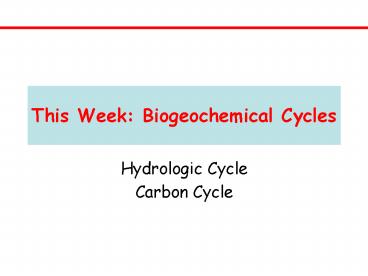This Week: Biogeochemical Cycles - PowerPoint PPT Presentation
1 / 30
Title:
This Week: Biogeochemical Cycles
Description:
Hydrologic Cycle Carbon ... Atmosphere 790 Gtons Ocean 3.7x104 Gtons Lithosphere 4x107 Gtons Mainly as CO2 Mainly as HCO3- Mainly as CaCO3 Carbon in the oceans is ... – PowerPoint PPT presentation
Number of Views:302
Avg rating:3.0/5.0
Title: This Week: Biogeochemical Cycles
1
This Week Biogeochemical Cycles
- Hydrologic Cycle
- Carbon Cycle
2
Announcements
- Reading Chapters 4 (p. 74 81) and 8
- Another Problem Set (Due next Tuesday)
- Exam 2 Friday Feb 29
- My office hours today and next week rescheduled
to Thurs 3 - 4 pm
3
Water Cycle Box Model
Burden amount of material in reservoir
Source/Sink flow rate into/out of reservoir
Reservoir region where material stored each box
4
Theres 1.3x1018 m3 of H2O in the oceans. About
3.6x1015 m3 of H2O per year evaporate from the
oceans. How long does the average H2O molecule
reside in the ocean?
- 36 years
- 360 years
- 3600 years
5
Precipitable Water Distribution
Precipitable water greatest over oceans, in
tropics.
6
Spatially Resolved Precipitation Rate
Subsiding branches of Hadley Cells
7
Precipitation Rate Minus Evaporation Rate
green (positive) net water gain yellow/brown
(negative) net water loss
8
Water Cycle and Terrestrial Biosphere
Forest
Grassland
Tundra
Precipitation
Desert
0oC
Temperature
9
Precipitation Changes with Global Warming
Climate Model Predictions
10
Announcements
- Problem Set 4 Due Tuesday Feb 26
- Group Choices by Friday
- Seminar on Thursday 1230 310c ATG
11
Carbon Cycle
- Short-term biosphere-driven cycle
- Terrestrial biosphere
- Marine biosphere
- Long-term inorganic cycle
- Weathering-volcanism thermostat
12
Global Biogeochemical Cycles
Oxidation
Oxidized gas/ particle
Reduced gas
Emission
Deposition
Uptake
EARTH SURFACE
Reduction
13
Atmospheric CO2 Seasonal Cycle
Atmosphere responds to biosphere on short
timescales
14
Mass Units of Geologic Scale
- 1 Gigaton 1x109 tons 1x1012 kg 1 x 1015
grams 1 Petagram - 1 Gigaton 1 Petagram
15
Terrestrial Biosphere C Cycle
Flows in units of Gtons C per year
Atmosphere 780 Gtons
NPP 60
Decay/resp 49
52
Living Biomass 750 Gtons
Litter 110 Gtons
Decay/resp 11
8
3
Steady State? Longest lifetime? Shortest lifetime?
Soil 2000 Gtons
16
The effect of deforestation on atmospheric CO2 is
- to increase it (source)
- to decrease it (sink)
- negligible
17
Under conditions of higher CO2 (and sufficient
nutrient supply), plants have been shown to
increase photosynthesis rates.
- Positive feedback
- Negative feedback
- Not a feedback
18
Marine Organic C Cycle
Photosynthesis
Surface Ocean
CO2(aq) nutrients
decay
Deeper Ocean
19
Biological OrgC Pump Key Points
1. Surface depleted (relatively) in C and
nutrients 2. Deep ocean enriched in C and
nutrients 3. Atmospheric CO2 responds to net
pumping
CO2 and nutrients pumped down by biota
Thermo-Haline Circulation
1000 yrs
Surface Ocean
Deeper Ocean
OrgC O2
CO2(aq)
20
Marine Productivity
Global map of ocean color from SEAWIFS satellite
chlorophyll ?phytoplankton (where the nutrients
are)
remember upwelling and convection?
21
Reservoirs of (Inorganic) Carbon
Atmosphere 790 Gtons
Mainly as CO2
Ocean 3.7x104 Gtons
Mainly as HCO3-
Lithosphere 4x107 Gtons
Mainly as CaCO3
Carbon in the oceans is mostly in an inorganic
form
22
Shell Formation
Shell formation (CaCO3(s))
Surface Ocean
CO32- Ca2
Deep Ocean
23
Carbonate shell formation ___________ the oceans
capacity to take up atmospheric CO2
- increases
- decreases
24
The Ultimate Inorg C Cycle
Chemical Weathering
CaSiO3 CO2
CaCO3 SiO2
Volcanism
25
Silicate Weathering
CaSiO3 CO2 ? CaCO3 SiO2
Rain/runoff
Ca2 CO32- SiO2
CO2 (atm)
CaCO3 SiO2
CaSiO3 Rock
CaSiO3 Rock
Oceans
Chemical Weathering Rate ?Faster with higher CO2,
higher T, higher rainfall
26
Volcanic Degassing
Volcanism causes reverse of weathering
HEAT
CaSiO3 CO2 CaCO3 SiO2
Tectonic activity converts CaCO3 rocks back to
silicate rocks in the mantle (magma). CO2
released finds way to atmosphere via vents
27
Silicate Weathering Thermostat
CO2
Chemical weathering
CaSiO3 ? CaCO3 SiO2
Precip/runoff
CaCO3 SiO2
burial
CaCO3 SiO2
CaCO3 SiO2 ? CaSiO3 CO2
This cycle operates on 0.5 1 million year
timescale.
28
Is the silicate weathering volcanism InorgC
cycle a positive or negative feedback?
- Positive
- Negative
29
Silicate Weathering Feedback
Negative FeedbackStabilizing Climate
-
CO2
Silicate Weathering Rate
Initial Forcing
30
Does the silicate weathering feedback loop
explain the glacial-interglacial cycling of
atmospheric CO2?
- Yes
- No































